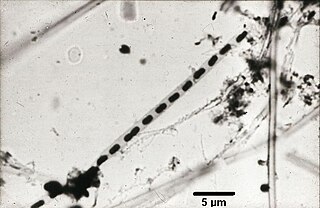Related Research Articles

The Comamonadaceae are a family of the Betaproteobacteria. Like all Pseudomonadota, they are Gram-negative. They are aerobic and most of the species are motile via flagella. The cells are curved rod-shaped.
Oceanospirillaceae is a family of Pseudomonadota. Most genera in this family live in environments with high concentrations of salt; they are halotolerant or halophilic. They are marine, except Balneatrix which is found in fresh water and Venatorbacter, which is from terrestrial origin.All members are strictly aerobic, except Neptunomonas which can perform fermentation reactions.
The Lachnospiraceae are a family of obligately anaerobic, variably spore-forming bacteria in the order Eubacteriales that ferment diverse plant polysaccharides to short-chain fatty acids and alcohols (ethanol). These bacteria are among the most abundant taxa in the rumen and the human gut microbiota. Members of this family may protect against colon cancer in humans by producing butyric acid. Lachnospiraceae have been found to contribute to diabetes in genetically susceptible (ob/ob) germ-free mice.
Cyclobacterium marinum is a bacterium from the genus of Cyclobacterium which has been isolated from coelomic fluid of a sand dollar from the Newport Beach in the United States. "cyclobacterium marinum" produces homospermidine
Desulfonema is a Gram-negative bacteria genus from the family Desulfococcaceae.
Microbacterium terrae is a bacterium from the genus of Microbacterium which has been isolated from soil in Osaka on Japan.
Microbacterium thalassium is a bacterium from the genus of Microbacterium which has been isolated from the rhizosphere from mangrove trees on Japan.
Buttiauxella is a Gram-negative, aerobic, facultative anaerobic and motile genus of bacteria within the family of Enterobacteriaceae.
Buttiauxella agrestis is a bacterium from the genus of Buttiauxella which has been isolated from soil. Buttiauxella agrestis can cause surgical site infections
Buttiauxella brennerae is a bacterium from the genus of Buttiauxella which has been isolated from a snail in Braunschweig in Germany.Buttiauxella brennerae is named after the American microbiologist W. Hickmann-Brenner.
Buttiauxella ferragutiae is a bacterium from the genus of Buttiauxella which has been isolated from soil in France.
Buttiauxella gaviniae is a bacterium from the genus of Buttiauxella which has been isolated from a snail in Braunschweig in Germany. Buttiauxella gaviniae is named after the French microbiologist Françoise Gavini.
Buttiauxella izardii is a bacterium from the genus of Buttiauxella which has been isolated from a snail in Braunschweig in Germany. Buttiauxella izardii is named after the French microbiologist Daniel Izard.
Buttiauxella noackiae is a Gram-negative bacterium from the genus of Buttiauxella which has been isolated from a snail in Sydney in Australia. Buttiauxella noackiae is named after Katrin Noack.
Lentzea flava is a bacterium from the genus Lentzea which has been isolated from soil. Lentzea flava produces madumycin.

Lentzea aerocolonigenes is a bacterium from the genus Lentzea which has been isolated from soil in Japan. Lentzea aerocolonigenes produces rebeccamycin.
Lentzea albida is a bacterium from the genus Lentzea which has been isolated from soil in Jiangxi, China. Lentzea albida produces staurosporine.
Pseudonocardia bannensis is a bacterium from the genus of Pseudonocardia which has been isolated from roots of the plant Artemisia annua in Yunnan in China.
Pseudonocardia hydrocarbonoxydans is a bacterium from the genus of Pseudonocardia which has been isolated from air contaminant. Pseudonocardia hydrocarbonoxydans can oxidize hydrocarbons.
Marinomonas is an aerobic bacteria genus from the family of Oceanospirillaceae.
References
- 1 2 Parte, A.C. "Buttiauxella". LPSN .
- ↑ "Buttiauxella warmboldiae Taxon Passport - StrainInfo". www.straininfo.net. Archived from the original on 2018-03-19. Retrieved 2017-07-16.
- ↑ "Buttiauxella warmboldiae". www.uniprot.org.
- ↑ Parker, Charles Thomas; Garrity, George M (2019). Parker, Charles Thomas; Garrity, George M (eds.). "Nomenclature Abstract for Buttiauxella warmboldiae". The NamesforLife Abstracts. doi:10.1601/nm.3123.
- ↑ "Details: DSM-9404". www.dsmz.de.
- ↑ editors, Don J. Brenner, Noel R. Krieg, James T. Staley (2005). Bergey's manual of systematic bacteriology (2nd ed.). New York: Springer. ISBN 0-387-28022-7.
{{cite book}}:|last1=has generic name (help)CS1 maint: multiple names: authors list (link)